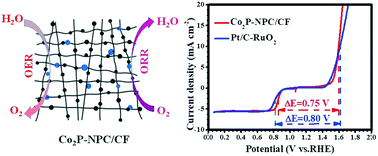A rationally designed bifunctional oxygen electrocatalyst based on Co2P nanoparticles for Zn–air batteries†
Abstract
Developing highly cost-effective bifunctional oxygen electrode catalysts for metal–air batteries is urgent but remains challenging. In this paper, we report a highly-efficient Co2P-based bifunctional oxygen electrocatalyst that comprises Co2P and N,P co-doped carbon nanoparticles anchored within three-dimensional carbon nanofiber networks (denoted as Co2P-NPC/CF) through a toxic-free, one-pot synthesis involving in situ growth of Co3(PO4)2–polydopamine/bacterial cellulose (BC) that can be transformed into Co2P-NPC/CF by a subsequent pyrolysis process. This catalyst exhibits a positive half-wave potential (E1/2) of 0.85 V for the oxygen reduction reaction, and a low operating potential of 1.60 V at 10 mA cm−2 (Ej10) for the oxygen evolution reaction, superior to the benchmark Pt/C (0.82 V) and RuO2 (1.62 V) catalysts, respectively. The reversible oxygen electrode index (ΔE = Ej10 − E1/2) is just 0.75 V for Co2P-NPC/CF, surpassing those for the state-of-the-art noble-metal catalysts (ΔE = 0.80 V for Pt/C–RuO2) and most Co-based bifunctional catalysts ever reported. Furthermore, Co2P-NPC/CF-based primary Zn–air batteries can discharge at 10 mA cm−2 for 110 h with a small voltage loss of 55 mV, and the maximum power density reaches 160 mW cm−2; Co2P-NPC/CF-based rechargeable Zn–air batteries show a negligible voltage gap change after 160 charge–discharge cycles, much better than Pt/C-based batteries. The enhanced bicatalytic performance of this Co2P-based catalyst can be ascribed to the structural integration of Co2P NPs with CF networks and N,P co-doped carbon in a synergistic manner, where porous CF networks with a large specific surface area allow for uniform distribution and full exposure of dual active sites, and the simultaneous doping of P and N atoms in carbon could induce an enhanced coupling of Co2P NPs with N,P-codoped carbon. This work not only provides an easy and safe way to prepare excellent Co2P-based bifunctional catalysts for Zn–air batteries, but also demonstrates a viable structural integration strategy to offer reference for the design of multifunctional catalysts.



 Please wait while we load your content...
Please wait while we load your content...